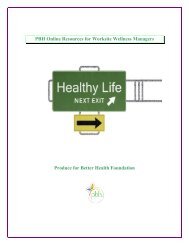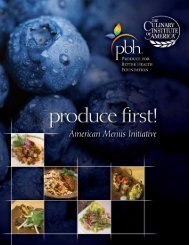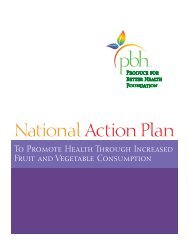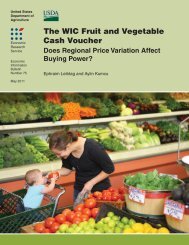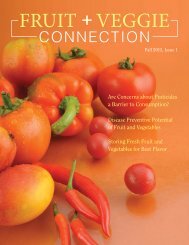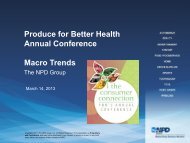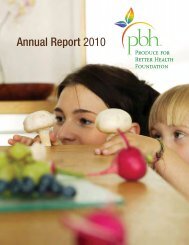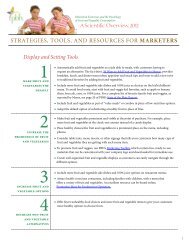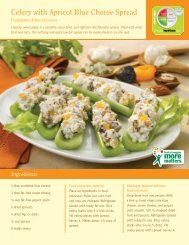Why All Forms Matter Brochure - Produce for Better Health Foundation
Why All Forms Matter Brochure - Produce for Better Health Foundation
Why All Forms Matter Brochure - Produce for Better Health Foundation
Create successful ePaper yourself
Turn your PDF publications into a flip-book with our unique Google optimized e-Paper software.
<strong>All</strong> <strong>for</strong>ms of fruits and vegetables provide needed nutrients<br />
From a nutrition and sensory standpoint,<br />
recipes prepared with canned and/or frozen<br />
ingredients have been rated as comparable to<br />
those prepared with cooked fresh ingredients. 8, 9<br />
Fruits and vegetables that are to be canned or<br />
frozen are packed within hours of harvest, so their<br />
peak flavor and nutritional value are preserved. Due<br />
to minimal deleterious oxygen during storage, the<br />
nutrients in canned and frozen fruits and vegetables<br />
remain relatively stable <strong>for</strong> consumption, allowing<br />
<strong>for</strong> a longer shelf-life. 9 The way to keep surplus<br />
product that is harvested during peak season—a<br />
season that may only last a few days or weeks—is to<br />
‘preserve’ it by canning or freezing it. Commercial<br />
preservation methods today are even better than<br />
grandmother’s, because the industry has learned to<br />
optimize conditions so that time and temperature<br />
exposures are better than that of grandmother’s<br />
kitchen.<br />
Dried fruits are a particularly significant source<br />
of dietary potassium and fiber. Depending on<br />
the specific fruit, they provide other important<br />
nutrients like vitamin A and carotenoids<br />
(dried peaches and apricots), vitamin K (dried<br />
plums), calcium (dried figs), manganese (dried<br />
figs), and boron (raisins and dried plums). 10<br />
When it comes to fruits and vegetables, think<br />
all <strong>for</strong>ms and include a colorful variety! Eating<br />
and drinking colorful fruits and veggies in all<br />
<strong>for</strong>ms provides a wide range of natural vitamins,<br />
minerals, phytochemicals, and fiber important to<br />
overall good health. With hundreds of different<br />
kinds of fruits and vegetables and thousands of<br />
different ways to prepare them, there’s bound to be<br />
something to please everyone. So, what are the best<br />
fruits and vegetables <strong>for</strong> consumers to buy? Quite<br />
simply, it’s the ones they enjoy, and the <strong>for</strong>ms that<br />
best fit into their lifestyle.<br />
Fresh, frozen, dried, and canned fruits and<br />
vegetables contain similar amounts of fiber and<br />
minerals. Cooking fruits or vegetables does not<br />
4, 11<br />
destroy fiber or minerals.<br />
Research shows that children and teens who<br />
drink 100% juice have higher usual intakes of<br />
vitamins A and C, magnesium, folate, phosphorus,<br />
calcium, and potassium—all nutrients<br />
that have been identified as frequently underconsumed<br />
by these age<br />
12, 13<br />
groups.<br />
Some packaged fruits and vegetables may actually contribute<br />
more health-promoting antioxidants than their fresh counterparts<br />
Most fat-soluble nutrients, including carotenoids,<br />
Vitamin A, and Vitamin E, are higher<br />
in processed fruits and vegetables. This is true,<br />
in part, because the mild heat treatment in processed<br />
products allows <strong>for</strong> greater bioavailability<br />
of lipid-soluble nutrients. Processed fruits and<br />
vegetables may also contain greater nutritional<br />
value because some processing cultivars are<br />
more nutritious than fresh cultivars, as is the<br />
case with tomatoes. 4<br />
One study demonstrated increased amounts of<br />
some key anthocyanins in canned blueberries, a<br />
powerful antioxidant, compared to the amounts<br />
found in fresh and frozen blueberries. 14<br />
The absorption of lutein found in corn, an antioxidant<br />
that may reduce the risks of cataracts and<br />
macular degeneration, is also enhanced by heat<br />
from the canning process. 15<br />
Dried fruit is an excellent source of phenolic compounds<br />
which contribute to the antioxidant capacity<br />
of fruits and vegetables. In fact, the antioxidant<br />
capacity is much higher <strong>for</strong> dried fruit than corresponding<br />
values <strong>for</strong> fresh because the antioxidants<br />
are concentrated into a smaller volume during the<br />
dehydration process. 10<br />
Mom’s Reported Uses of Different<br />
<strong>Forms</strong> of Fruits & Vegetables 16<br />
How do you use frozen and canned fruits<br />
and vegetables? (Please check all that apply.)<br />
% Respondents<br />
FRUITS VEGETABLES<br />
Frozen Canned Dried Frozen Canned<br />
Snacks 39% 64% 79%<br />
Dessert 54% 46%<br />
Smoothies/<br />
Beverages<br />
69% 16%<br />
Fruit Salads 29% 37%<br />
As is 33% 67%<br />
Baking 38%<br />
Trail mix 39%<br />
On cereal 31%<br />
In salads 30% 15% 16%<br />
Side dish 89% 89%<br />
Casseroles 52% 51%<br />
Soups/stews 54% 49%<br />
Stir-fry 49% 20%<br />
Add to sauces 18% 13%<br />
Other 4% 4% 1% 2% 1%<br />
Don’t use 1% 0% 5% 0% 0%<br />
(n=390) (n=687) (n=399) (n=854) (n=814)<br />
Empty boxes indicate the category was not presented to the respondent.<br />
Multiple <strong>for</strong>ms of fruits and vegetables mean<br />
added convenience and optimal nutrition<br />
Today’s consumers are pressed <strong>for</strong> time, so healthy<br />
products in convenient packages are perfect <strong>for</strong><br />
busy schedules. Having all <strong>for</strong>ms of fruits and vegetables<br />
on hand—fresh, frozen, canned, dried, and<br />
100% juice—makes them accessible, convenient,<br />
and ready-to-use when preparing meals and snacks<br />
at home.<br />
Some frozen foods come in resealable, easy open/<br />
reclose packaging, allowing <strong>for</strong> longer storage and<br />
portion control without waste. Microwaveable<br />
vegetables, frozen or fresh, also provide added<br />
convenience by allowing food to be cooked right in<br />
the package.<br />
Canned foods are cooked during processing, so<br />
they are ready to heat and eat or use in a recipe.<br />
Similarly, frozen foods require little preparation—<br />
they are pre-washed and pre-cut. Both fresh pro-<br />
duce and 100% juice can be consumed immediately<br />
after purchase with minimal, if any, preparation.<br />
Dried fruits and vegetables are easily stored and<br />
quickly accessible from the pantry. Dried fruit<br />
comes in convenient packages that can be stored<br />
and eaten on the go. They are nutritionally dense<br />
and provide a perfect healthy boost.<br />
Using more than one <strong>for</strong>m of fruit or vegetable <strong>for</strong><br />
a meal or side dish can mean less preparation and<br />
cooking time <strong>for</strong> today’s busy cooks. For example,<br />
here’s how to make a quick chili dish: add frozen<br />
corn to canned tomatoes and beans, season with<br />
fresh herbs, and top with fresh avocado. For a nutritious<br />
and easy-to-make beverage in seconds, add<br />
100% juice to frozen berries, along with milk and<br />
yogurt, and blend until smooth. Use 100% juice<br />
as an ingredient in sauces and marinades, adding<br />
variety and nutrition to favorite recipes.



